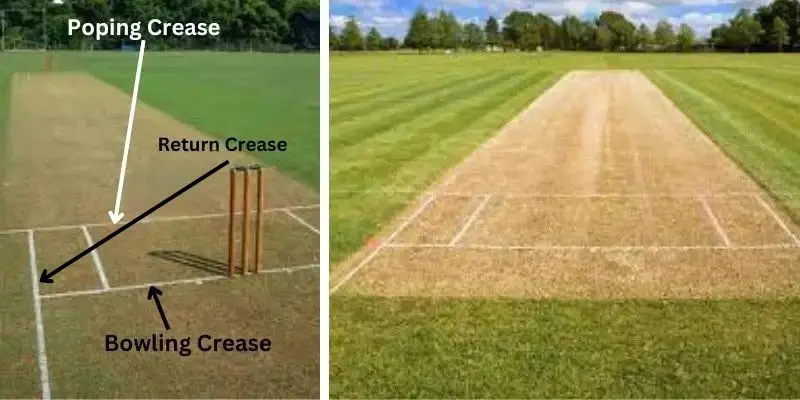What is the Crease in Cricket? Learn it’s Types Rules & Role in the Game
Published: 17 Feb 2025
Any sport without rules makes no sense. The same is true with the crease in cricket, it’s a game of rules, skills, and fine margins. One of the most important parts of the game is the crease—it’s a set of white lines on the pitch that decides the limitation of the bowler and the batter on the pitch. Also a yardstick for the legality of delivery and runs.
Have you ever wondered how these lines affect the game?
Let’s find out!……
Understanding the Crease
The crease is a set of lines on the 22-yard pitch that helps umpires make decisions. These simple-looking lines can change the outcome of a match!
Each type of crease has a different role in the game.

Types of Creases in Cricket (With Measurements)
Cricket has three main creases. Each one serves a different purpose.
1. Popping Crease / The Front Line of the Crease
- The popping crease is 4 feet (1.22 meters) in front of the stumps.
- Batters must stay behind this line to avoid being stumped or run out.
- The front foot of the bowler must not cross this line otherwise it will called a no-ball and the batter will get a free hit for that
- Fielders also use this line as a mark to take catches when standing near the stumps.
2. Bowling Crease
- The bowling crease runs 8 feet 8 inches (2.64 meters) across the pitch and marks the end of the pitch.
- The bowler’s front foot must stay behind this line while delivering the ball.
- Overstepping this line results in a no-ball, which gives the batter a free hit in limited-overs cricket.
3. Return Crease / Side Crease
- The return crease is a vertical line drawn 4 feet 4 inches (1.32 meters) from the middle stump.
- The bowler’s back foot must not be out of this line while bowling.
- If a bowler steps outside this crease, it results in a no-ball.
Why is the Crease Important?
The crease plays a crucial role for batters, bowlers, and umpires.
- For Batters: The batter has to remain within the crease while playing his shorts, which makes the game interesting. If a batter’s bat or foot is behind the popping crease, they cannot be run out or stumped.
- For Bowlers: The bowler has to take care of not overstepping the crease while delivering the ball.
- For Umpires: It helps them make decisions that the game is going fairly.
Interesting Facts About the Crease
Before white lines, cricketers used a simple scratch on the ground to mark the crease.
- MS Dhoni’s run-out in the 2019 World Cup semifinal showed how even an inch matters—he was just short of the crease when Martin Guptill’s throw hit the stumps!
- In Test cricket, batters can leave the crease after playing a shot, but in T20s and ODIs, they must be extra careful.
Common Mistakes Players Make with the Crease
Even professional cricketers make mistakes when it comes to the crease. Here are some common ones:

1. Batters Lifting Their Bat Too Early
- If a batter does not ground his bat properly while running, they can be run out.
- This mistake has cost teams important matches in history!
2. Bowlers Overstepping
- If a bowler’s front foot goes beyond the bowling crease, it’s a no-ball.
- No-balls can change a game—batters get a free hit, meaning they cannot be dismissed (except for a run-out).
3. Running Between the Wickets Without Awareness
- Some batters fail to stretch their bat to reach the crease while running.
- Even one inch short can result in a run-out!
A batsman can stand as far in front of the crease as they like. There is no rule restricting how far they can move forward. However, standing too far ahead has risks:
- LBW Decisions: If a batsman is too far forward, the umpire might find it harder to judge LBW decisions.
- Stumping Risk: If they step out and miss the ball, the wicketkeeper can stump them easily.
- Fast Bowler Tactics: Against fast bowlers, standing too far forward can reduce reaction time, making it harder to play fast deliveries.
Final Thoughts
The crease may seem like just a few white lines on the pitch, but it plays a massive role in cricket. It helps batters stay safe, bowlers follow the rules, and umpires make fair decisions.
Next time you watch a game, keep an eye on the crease—you might just witness a game-changing moment!
Did you know? A single inch can decide the fate of a match!






Hi, this is a very useful article. However, wanted to point out that, in your first image, the arrow wrongly points out the guide line for wides as the return crease. The other line on the left of that is the return crease.